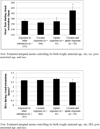Prenatal substance exposure: neurobiologic organization at 1 month
- PMID: 23743094
- PMCID: PMC3773295
- DOI: 10.1016/j.jpeds.2013.04.033
Prenatal substance exposure: neurobiologic organization at 1 month
Abstract
Objective: To examine the autonomic nervous system and neurobehavioral response to a sustained visual attention challenge in 1-month-old infants with prenatal substance exposure.
Study design: We measured heart rate, respiratory sinus arrhythmia, and neurobehavior during sustained visual orientation tasks included in the Neonatal Intensive Care Unit Network Neurobehavioral Scale in 1129 1-month-old infants with prenatal substance exposure. Four groups were compared: infants with prenatal cocaine and opiate exposure, infants with cocaine exposure, infants with opiate exposure, and infants with exposure to other substances (ie, alcohol, marijuana, and tobacco).
Results: The infants with prenatal exposure to both cocaine and opiates had the highest heart rates and lowest levels of respiratory sinus arrhythmia during a sustained visual attention challenge compared with the other 3 groups. Infants with prenatal cocaine and opiate exposure had poorer quality of movement and more hypertonicity during the Neonatal Intensive Care Unit Network Neurobehavioral Scale examination. They also had more nonoptimal reflexes and stress/abstinence signs compared with infants with prenatal exposure to cocaine only and those with prenatal exposure to alcohol, tobacco, and marijuana.
Conclusion: Problems with arousal regulation were identified in infants with prenatal substance exposure. Autonomic dysregulation has been implicated as a mechanism by which these difficulties occur. Our results suggest that infants with prenatal exposure to both cocaine and opiates have the greatest autonomic response to the challenge of a sustained visual attention task, possibly putting these infants at risk for problems associated with physiologic and behavioral regulation, a necessary prerequisite for early learning.
Keywords: ECG; Electrocardiography; HR; Heart rate; NNNS; Neonatal Intensive Care Unit Network Neurobehavioral Scale; PMA; Postmenstrual age; RSA; Respiratory sinus arrhythmia.
Copyright © 2013 Mosby, Inc. All rights reserved.
Conflict of interest statement
Funding and conflict of interest information is available at
Figures
References
-
- Mayes LC, Grillon C, Granger R, Schottenfeld R. Regulation of arousal and attention in preschool children exposed to cocaine prenatally. Ann N Y Acad Sci. 1998;846:126–143. - PubMed
-
- Blechert J, Michael T, Grossman P, Lajtman M, Wilhelm FH. Autonomic and respiratory characteristics of posttraumatic stress disorder and panic disorder. Psychosom Med. 2007;69:935–943. - PubMed
-
- Berntson GG, Bigger JT, Jr, Eckberg DL, Grossman P, Kaufmann PG, Malik M, et al. Heart rate variability: origins, methods, and interpretive caveats. Psychophysiology. 1997;34:623–648. - PubMed
-
- Grossman Respiration, stress, and cardiovascular function. Psychophysiology. 1983;20:284–300. - PubMed
Publication types
MeSH terms
Substances
Grants and funding
- U10 HD027856/HD/NICHD NIH HHS/United States
- U10-HD-27904/HD/NICHD NIH HHS/United States
- F32DA032175/DA/NIDA NIH HHS/United States
- N01 HD023159/HD/NICHD NIH HHS/United States
- N01-HD-2-3159/HD/NICHD NIH HHS/United States
- U10 HD021385/HD/NICHD NIH HHS/United States
- U10-DA-024118-01/DA/NIDA NIH HHS/United States
- U10-HD-21385/HD/NICHD NIH HHS/United States
- U10-DA-024119-01/DA/NIDA NIH HHS/United States
- U10 HD027904/HD/NICHD NIH HHS/United States
- U10 HD021397/HD/NICHD NIH HHS/United States
- U10-HD-2786/HD/NICHD NIH HHS/United States
- I10-DA-024128-06/DA/NIDA NIH HHS/United States
- U10-HD-21397/HD/NICHD NIH HHS/United States
- U10-DA-024117-01/DA/NIDA NIH HHS/United States
- F32 DA032175/DA/NIDA NIH HHS/United States
LinkOut - more resources
Full Text Sources
Other Literature Sources


